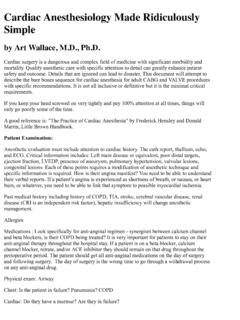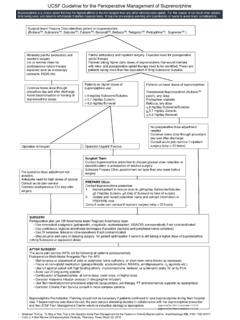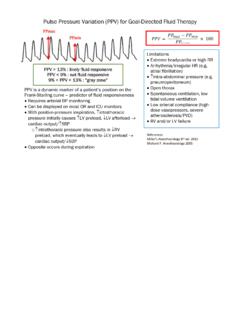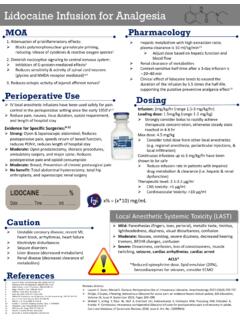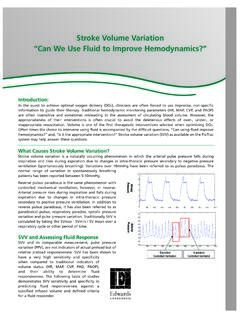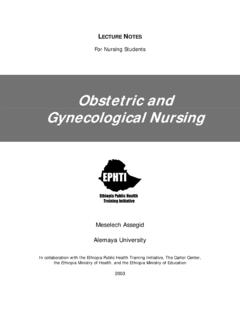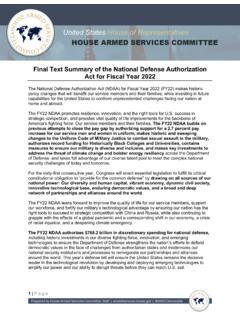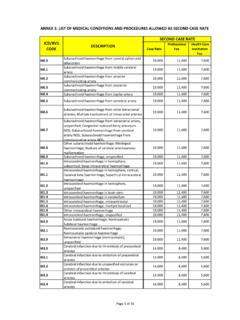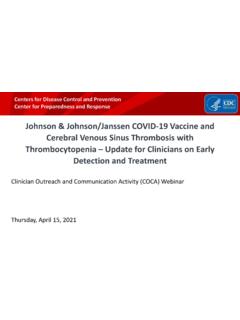Transcription of Pocket Anesthesia
1 High Spinal & Total SpinalSigns Numbness, paresthesia, or weakness of UE s Rapid unexpected rise of sensory block SOB, apnea, bradycardia, hypotension, or nausea/vomiting Loss of consciousness (LOC = total spinal), Cardiac arrestTx Call for help & code cart, inform team If cardiac arrest: start CPR, refer to ACLS protocol Support ventilation. Intubate if necessary If significant brady or hypotension: 10mcg boluses epi, prn, consider ACLS/pacing pads If mild brady can try atropine, low threshold for epi Give IV fluid bolus IF PARTURIENT: LUD, alert OB, prepare for possible C/S, monitor fetal HR. If arrest, see ACLS in parturientPocket Anesthesia Reference CardCard design by providers from many institutions including:Disclaimer: This card is intended to be educational in nature and is not a substitute for clinical decision making based on the medical condition presented.
2 It is intended to serve as an introduction to terminology. It is the responsibility of the user to ensure all information contained herein is current and accurate by using published references. This card is a collaborative effort by representatives of multiple academic medical Fluids - 4-2-1 Rule4 mL/kg/hr: each kg up to 10 kg2 mL/kg/hr: each additional kg to 20 kg1 mL/kg/hr: each additional kg > 20 kgExample: a 22 kg pt needs 40+20+2 = 62ml/hr)Average Blood Volume (ABV)Premature90-100 ml/kg1yo75 ml/kgTerm 80 ml/kgAdult 70 ml/kgCalculation of Drug ConcentrationsPercentage solutions: 100% solution = 1g/ml To convert: multiply % by 10 Ratio solutions: Number before : = grams in solution. Number after : = mls in solution. To convert ratio to g/ml divide grams by mls.
3 1% solution = 1:100 = 10mg/ml = 1:200,000 = or 5 mcg/mlAllowable Blood Loss (ABL)Est blood volume (EBV) = Kg x Average Blood Volume (ABV)Allowable Blood Loss (ABL) = [EBV x (initial Hgb-final Hgb)]/initial HgbNPO Guidelines (Hrs)Clears 2 Formula, milk, light meal 6 Breast Milk 4 Full meals 8 GENERAL Anesthesia KNOWLEDGE EMERGENCIES Hypotension in Spinal AnesthesiaMost pts. receiving spinal Anesthesia will need vasopressor support. Prevention See contraindications Bolus 500-1000ml IVF at time of placement & consider preemptive phenylephrine : AMS: confusion, agitation, somnolence, unconsciousness Nausea, vomiting Inability for BP cuff to read Increased HRTx: IV ephedrine 5-10mg or IV phenylephrine 50-100mg Will likely need phenylephrine infusion Pt positioning (left lateral + reverse trendelenburg)Common Local Anesthetics for Spinal Anesthesia ~Dose, mg~Durationw/ epi Procedure < 90 min Chloroprocaine40-60n/aLidocaine 2% 60-8030-45 Lidocaine 5% (Avoid 2/2 TNS)60-7560-70 Procaine75-2004560-75 Procedure > 90 min Bupivacaine or (iso or hyperbaric )5-2090-110100-150 Tetracaine ANESTHESIAC ommon Adjuncts for Spinal Anesthesia 2hr & 6-12hr: only for postop pain.
4 Must monitor 24 hrs due to risk of delayed respiratory depressionClonidine (caution black box warning for maternal hypoTN and bradycardia)30-60 mcgCommon mix: mg hyperbaric bupiv +/- 10-15 mcg fentanyl +/- 100-150 mcg morphine +/- 50-100 mcg epinephrineKey Points Uses: C/S, Gyn, Uro, Abdo & LE procedures High spinal is a significant cause of morbidity/mortality see emergencies Monitor BP q1-5 min before, during, & after. Use standard monitors Ensure adequate IV access, vasoconstrictors & GA available Consider preloading with IVF (Avoid in pre-eclampsia) Consider starting vasopressor support at time of placement Ensure aseptic technique for placement Spread determined by: baricity, dose, volume, position, level of injection, CSF volume( intra-abdominal pressure, pregnancy)PPH EBL: Vaginal: > 500 mL, C-section: > 1000 mL 4 T s: Tone/atony, Thrombin/coags, Tissue/retained placenta, Trauma/artery lacOxytocin/Pitocin(Syntocinon)-Can be given: IM/IV/IU routes (WHO rec: 10 U IM/IV)-Do NOT bolus IV rapidly-Consider Rule of 3 s: -Dose.
5 3 U load IV over 30 sec -Consider repeat 3 U doses q 3 min for total 3 doses-Infusion at 3 U/hr for up to 9 hr postop-COMMUNICATE w/ OB TEAM re: TONE q 3 min -SE: hypotension, N/V, coronary spasm Methylergonovine/Methergine- Dose: mg IM; q 5-10 min max 2 doses, then q 2-4 hr- Avoid IV, but if IV, mg/10 mL NS, give 2 mL q 1 min- Relatively contraindicated if GHTN, HTN, Pre-E- SE: HTN, seizures, HA, N/V, chest tightnessHemabate/Carboprost- Dose: mg only IM or IU q 15-90 min, Max 2 mg/24 hr- Contraindicated in asthma- SE: N/V, flushing, bronchospasm, diarrheaMisoprostol/Cytotec- Dose: 600-1000 mcg buccal/PR (10 min onset)- SE: temp to ~ , N/V, diarrheaTranexamic Acid/TXA- Consider for all PPH- Dose: 1 g IV over 10 min, repeat x 1 after 30 min prnFibrinogen concentrate/ RiaSTAP- Consider for PPH w/ confirmed/suspected low fib state.
6 (DIC, AFE, abruption, major hemorrhage )- 2 g fibrinogen = 2 vials RiaSTAP = 2-4 U FFP = 10-20 cryo U - To fibrinogen 100 mg/dL, give 2-4 g fibrinogen conc- Keep pt. warm- Don t forget CaCl - Consider IR for uterine artery embolization- Call for help- Consider MTP, cell salvage - Consider POC testing/ROTEM- Syntometrine = oxytocin + ergometrine- Prepare for hysterectomy if bleeding still uncontrolled ( IV access, consider airway) post - partum HemorrhageUrgent or Emergent C-Section & Emergent GAFor all: Pre-induction checklist Call for help, take AMPLE Hx, IV access, NaCit, pulse ox, LUD. Neuraxial preferred if time - plan determined by degree of urgency, communication w/OB team, resources, & pt. condition If CS for fetal distress, O2 to baby: SPOILT-Stop oxytocin, Position-LUD, O2, IV fluid, Low BP (give pressor), Tocolytics (terbutaline 250 mcg subQ, +/-NTG SL spray 400 mcg x2)For Emergent GA: ENSURE OBs PREPPED AND DRAPED BEFORE INDUCTION Pre-oxygenate 4 breaths.
7 RSI w/ cricoid: Meds: Sux mg/kg w/ either: propofol 2-3 mg/kg or etomidate mg/kg or ketamine 1-2 mg/kg or thiopental 4-5 mg/kg Once ETT placement verified, INSTRUCT SURGEONS TO CUT Until cord clamp: High gas flow & 2 MAC. Try to avoid benzo/narcs After cord clamp: MAC + 70% N2O or TIVA .Benzo/narcs OK When able: Timeout, Abx, OG, +/-NMB, +/- post -op TAP block or PCAC-section Antibiotics Standard: Cefazolin 2 gm IV (3 g if > 120 kg) Q 4 hr PCN-allergic: Clindamycin 900 mg IV q 6 hr & Gentamicin 5 mg/kg IV once High-risk (discuss w/ OB): Cefazolin as above & Azithromycin 500 mg IV x 1 (Do NOT re-dose azithro & infuse over 1 hr, faster risks local IV site rxn)OBSTETRICS & OB EMERGENCIES(Please see full OB Pocket card for details)Hypertensive DisordersPre-Eclampsia: BP > 140/90 x2 20 wks, proteinuria, +/- organ dysfunct.
8 Consider delivery Prevent seizure: Mg 4-6 g IV over 15-20 min + 1-2 g/hr gtt for 24 hr post delivery (do NOT d/c in OR); (10 g IM load described if no PIV) Tx severe HTN (SBP > 155, DBP > 105): 1st line: Labetalol IV, hydralazine IV, nifedipine PO and no IV (others okay if 1st line unavailable) Watch for Mg tox: DTRs, Resp/cardiac comp. Tx: CaCl 1g IV or CaGluc 1-3 g IVEclampsia: Pre-E w/ Seizure Goal: prevent hypoxia, trauma, additional seizures. Tx HTN, eval for prompt delivery LUD/full lateral, O2, airway, +/- ETT (If intubation: control BP to avoid cerebral hemorrhage ) IV Mg load & gtt, as above If persistent/recurrent seizure: IV benzo (IM/IO okay) If severe HTN, tx as above Prepare for prompt delivery (NO neuraxial until rule out HELLP)HELLP: hemolysis, LFTs, plt Tx.
9 As above for seizure ppx, HTN, consider delivery (vaginal if able) If active bleeding, consider plt transfusion Prepare for delivery, likely GA if C-Section (Control BP to avoid cerebral hemorrhage )Normal Physiologic Parameters & EquipmentAGEKGHRMAP**RRLMAB ladeETT mmETT@ Lips0-1mo<1*140 s30<601 Miller cm*0-1mo1-2*140 s30 s<601 Miller cm*0-1mo2-3*130-14030 s<601 Mil 0/Mil cm*0-1mo>3130-14040 s<601 Mil 0/Mil cm1-6 mo4-6130 s50 cm6mo-1yr6-10130 s60 cm1-2 yr10-12120 s60 s20-242 Wis cm2-4 yr12-16110 s60 cm4-6 yr16-2090-11070 s16-202 Mil 2 cm6-8 yr20-3090 s70 2 cm9-12 yr30-458070-80 s12-183 Mil/Mac cm>14 yr>507570-80 s10-164 Mil/Mac & Peds General Estimates The Neonatal 1-2-3(kg)/7-8-9(ETT@Lips) Rule For preterm & term newborns: MAP equals the # of weeks post conceptual age(PCA)!
10 By day of life 5, MAP = # of weeks PCA + 5 ETT Size: (Age/4) + 4 or 5th finger size ETT Depth: [(Height in cm)/10]+ 5 or 3 x ETT Size Age + 11 cm at lipIntraop Glucose for Infants and NeonatesFor any NPO infant < 6mo & recommended for infants that are: 1.< 45 wks PCA* * , have fever or shock* to diabetic mothers**will have higher glucose TPN or inborn errors of metabolism/TCA long proceduresTypical basal glucose requirement: 5-8 mg/kg/min. If in doubt, start at 5, adjust prn. PEDIATRICS & NEONATES OBSTETRICS & OB EMERGENCIES(Please see full OB Pocket card for details)*Redose Cefazolin/Clinda if EBL > 1500mlExamples: Anesthesia /Pre-Induction Checklist MSMAID Gelb et al 2018 MMachine: Complete standard machine check Ensure backup ventilation and O2 availableSSuction: Confirm suction is available and workingMMonitors: Standard: Pulse Ox, BP, EKG, Capnography, Temp Consider adjuncts: palpate pulse, auscultation, : Confirm appropriate plan and backup Prepare mask, ETT/LMA, laryngoscope/blades, bougie, tape/tie Optimize intubation positioning (sniffing, ramp)IIV: Confirm adequate number & flow of IV sDDrugs: Availability of standard & emergency meds Always know who to call for help!

